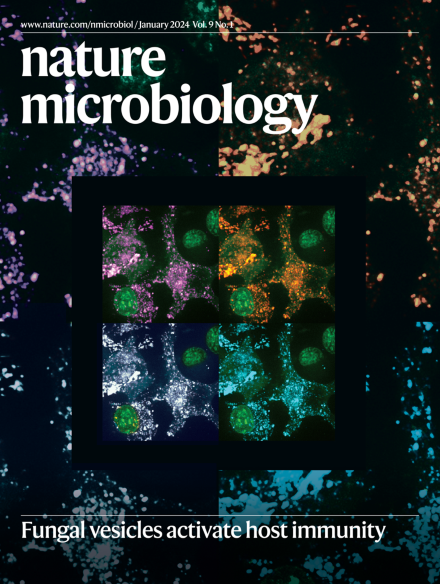人类真菌病原体的细胞外囊泡特征
IF 20.5
1区 生物学
Q1 MICROBIOLOGY
引用次数: 0
摘要
自2007年发现真菌胞外囊泡(EVs)以来,人们越来越意识到其在真菌生理学、宿主-病原体相互作用和毒力方面的重要性。真菌EVs是由多层膜和多种类型分子组成的纳米结构,参与真菌生物学的多种病理生理过程,包括分泌、细胞通讯、免疫发病和耐药。然而,关于电动汽车的分类,它们的细胞起源,通过细胞壁,功能和成分分析的实验模型,体外和体内的生产以及电动汽车的生物标志物,仍然存在许多问题。在这里,我们讨论了真菌ev文献中的空白,并确定了该领域的关键问题。我们介绍了真菌EV的发现历史,讨论了真菌EV生物学中五个主要未解决的问题,并展望了真菌EV研究的未来前景。我们主要集中讨论人类真菌病原体,但也扩展到包括其他真菌的知识,如植物病原体。有了这个观点,我们希望激发新的方法和扩大研究,以了解真菌ev的生物学。本文章由计算机程序翻译,如有差异,请以英文原文为准。


Characterizing extracellular vesicles of human fungal pathogens
Since their discovery in 2007, there has been growing awareness of the importance of fungal extracellular vesicles (EVs) for fungal physiology, host–pathogen interactions and virulence. Fungal EVs are nanostructures comprising bilayered membranes and molecules of various types that participate in several pathophysiological processes in fungal biology, including secretion, cellular communication, immunopathogenesis and drug resistance. However, many questions remain regarding the classification of EVs, their cellular origin, passage across the cell wall, experimental models for functional and compositional analyses, production in vitro and in vivo and biomarkers for EVs. Here, we discuss gaps in the literature of fungal EVs and identify key questions for the field. We present the history of fungal EV discovery, discuss five major unanswered questions in fungal EV biology and provide future perspectives for fungal EV research. We primarily focus our discussion on human fungal pathogens, but also extend it to include knowledge of other fungi, such as plant pathogens. With this Perspective we hope to stimulate new approaches and expand studies to understand the biology of fungal EVs. In this Perspective, Rodrigues et al. discuss the discovery of fungal extracellular vesicles, key unanswered questions in the field and future research directions.
求助全文
通过发布文献求助,成功后即可免费获取论文全文。
去求助
来源期刊

Nature Microbiology
Immunology and Microbiology-Microbiology
CiteScore
44.40
自引率
1.10%
发文量
226
期刊介绍:
Nature Microbiology aims to cover a comprehensive range of topics related to microorganisms. This includes:
Evolution: The journal is interested in exploring the evolutionary aspects of microorganisms. This may include research on their genetic diversity, adaptation, and speciation over time.
Physiology and cell biology: Nature Microbiology seeks to understand the functions and characteristics of microorganisms at the cellular and physiological levels. This may involve studying their metabolism, growth patterns, and cellular processes.
Interactions: The journal focuses on the interactions microorganisms have with each other, as well as their interactions with hosts or the environment. This encompasses investigations into microbial communities, symbiotic relationships, and microbial responses to different environments.
Societal significance: Nature Microbiology recognizes the societal impact of microorganisms and welcomes studies that explore their practical applications. This may include research on microbial diseases, biotechnology, or environmental remediation.
In summary, Nature Microbiology is interested in research related to the evolution, physiology and cell biology of microorganisms, their interactions, and their societal relevance.
 求助内容:
求助内容: 应助结果提醒方式:
应助结果提醒方式:


